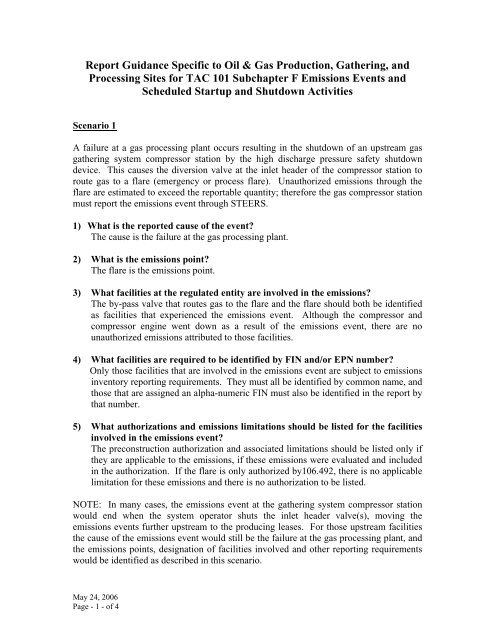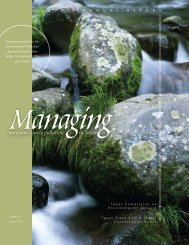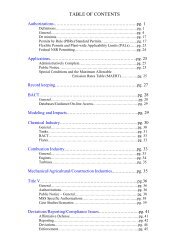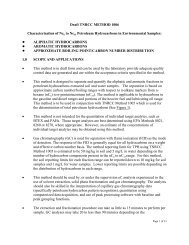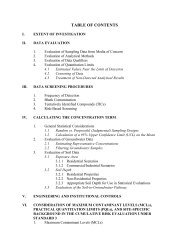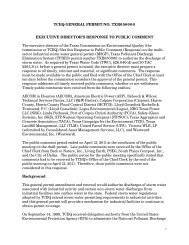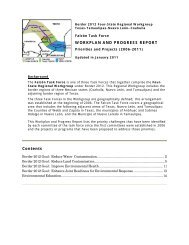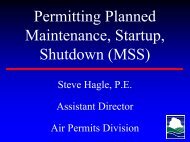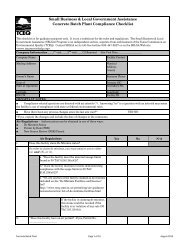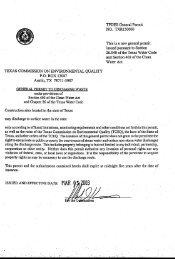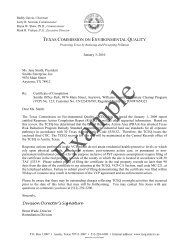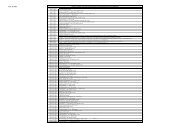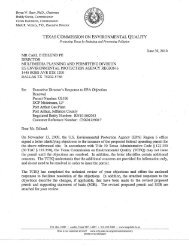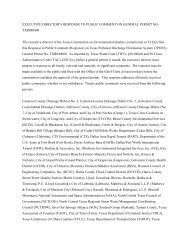Report Guidance Specific to Oil & Gas ... - TCEQ e-Services
Report Guidance Specific to Oil & Gas ... - TCEQ e-Services
Report Guidance Specific to Oil & Gas ... - TCEQ e-Services
You also want an ePaper? Increase the reach of your titles
YUMPU automatically turns print PDFs into web optimized ePapers that Google loves.
<strong>Report</strong> <strong>Guidance</strong> <strong>Specific</strong> <strong>to</strong> <strong>Oil</strong> & <strong>Gas</strong> Production, Gathering, and<br />
Processing Sites for TAC 101 Subchapter F Emissions Events and<br />
Scheduled Startup and Shutdown Activities<br />
Scenario 1<br />
A failure at a gas processing plant occurs resulting in the shutdown of an upstream gas<br />
gathering system compressor station by the high discharge pressure safety shutdown<br />
device. This causes the diversion valve at the inlet header of the compressor station <strong>to</strong><br />
route gas <strong>to</strong> a flare (emergency or process flare). Unauthorized emissions through the<br />
flare are estimated <strong>to</strong> exceed the reportable quantity; therefore the gas compressor station<br />
must report the emissions event through STEERS.<br />
1) What is the reported cause of the event?<br />
The cause is the failure at the gas processing plant.<br />
2) What is the emissions point?<br />
The flare is the emissions point.<br />
3) What facilities at the regulated entity are involved in the emissions?<br />
The by-pass valve that routes gas <strong>to</strong> the flare and the flare should both be identified<br />
as facilities that experienced the emissions event. Although the compressor and<br />
compressor engine went down as a result of the emissions event, there are no<br />
unauthorized emissions attributed <strong>to</strong> those facilities.<br />
4) What facilities are required <strong>to</strong> be identified by FIN and/or EPN number?<br />
Only those facilities that are involved in the emissions event are subject <strong>to</strong> emissions<br />
inven<strong>to</strong>ry reporting requirements. They must all be identified by common name, and<br />
those that are assigned an alpha-numeric FIN must also be identified in the report by<br />
that number.<br />
5) What authorizations and emissions limitations should be listed for the facilities<br />
involved in the emissions event?<br />
The preconstruction authorization and associated limitations should be listed only if<br />
they are applicable <strong>to</strong> the emissions, if these emissions were evaluated and included<br />
in the authorization. If the flare is only authorized by106.492, there is no applicable<br />
limitation for these emissions and there is no authorization <strong>to</strong> be listed.<br />
NOTE: In many cases, the emissions event at the gathering system compressor station<br />
would end when the system opera<strong>to</strong>r shuts the inlet header valve(s), moving the<br />
emissions events further upstream <strong>to</strong> the producing leases. For those upstream facilities<br />
the cause of the emissions event would still be the failure at the gas processing plant, and<br />
the emissions points, designation of facilities involved and other reporting requirements<br />
would be identified as described in this scenario.<br />
May 24, 2006<br />
Page - 1 - of 4
<strong>Report</strong> <strong>Guidance</strong> <strong>Specific</strong> <strong>to</strong> <strong>Oil</strong> & <strong>Gas</strong> Production, Gathering, and Processing Sites<br />
for TAC 101 Subchapter F<br />
Emissions Events and Scheduled Startup and Shutdown Activities<br />
Scenario 2<br />
A gas processing plant plans scheduled maintenance and coordinates with the opera<strong>to</strong>rs<br />
of the gas gathering system and the producing leases served by the gas gathering system.<br />
For the purposes of this example, it is presumed that the gathering system opera<strong>to</strong>r will<br />
be able <strong>to</strong> coordinate shutdown and startup with the gas plant in such a manner that the<br />
gathering system experiences no unauthorized emissions associated with the scheduled<br />
maintenance activity at the gas plant. At the producing leases, the increase in pipeline<br />
pressure upstream of the compressor prevents additional lease gas from entering the<br />
pipeline. The pressure relief valve on the emergency flare line diverts produced gas from<br />
the gas-liquid separa<strong>to</strong>rs <strong>to</strong> the emergency flare (which has no “permitted emissions”) <strong>to</strong><br />
prevent a separa<strong>to</strong>r malfunction and overflow of liquids at the lease.<br />
The opera<strong>to</strong>rs of the producing leases can submit STEERS notifications of a scheduled<br />
maintenance startup and shutdown activity 10 days (or as soon as practicable) prior <strong>to</strong> the<br />
maintenance activities, providing the required information in TAC 201.211(a) and (b) for<br />
the initial notice and final report.<br />
1) The expected duration and quantities for emissions from the regulated entity must be<br />
provided. If the <strong>to</strong>tal predicted emissions at the reporting regulated entity are<br />
exceeded by at least a reportable quantity, then the entire maintenance activity<br />
becomes an emissions event for the reporting regulated entity.<br />
2) Each STEERS report for a regulated entity will list the name of the owner or<br />
opera<strong>to</strong>r of the reporting regulated entity, the RN number, and the location of the<br />
emission point(s) at the reporting regulated entity with unauthorized emissions<br />
caused by the scheduled maintenance.<br />
3) The type of scheduled maintenance, startup, or shutdown activity and the reason for<br />
the scheduled activity may be listed as “Planned maintenance activities at the<br />
(name of gas processing plant).”<br />
4) The facilities which had unauthorized emissions as a result of the maintenance<br />
activity are the emergency flare (the source of the combustion products emitted)<br />
and the pressure relief valve (which is the facility that routed the uncombusted<br />
emissions <strong>to</strong> the flare). The emissions point is the emergency flare.<br />
5) For the purposes of this example, presume that the regulated entity in question is<br />
not NOW a “major” facility and does not submit an emissions inven<strong>to</strong>ry, but it<br />
was “major” and did submit an emissions inven<strong>to</strong>ry two years ago. The pressure<br />
relief valve has no emissions in normal operations and was never assigned a FIN.<br />
Since this site no longer is subject <strong>to</strong> emissions inven<strong>to</strong>ry requirements, the FIN<br />
and EPN numbers reported for the emergency flare would be “N/A.” (The<br />
May 24, 2006<br />
Page - 2 - of 4
<strong>Report</strong> <strong>Guidance</strong> <strong>Specific</strong> <strong>to</strong> <strong>Oil</strong> & <strong>Gas</strong> Production, Gathering, and Processing Sites<br />
for TAC 101 Subchapter F<br />
Emissions Events and Scheduled Startup and Shutdown Activities<br />
definition for “Agency established facility identification number” applies only <strong>to</strong><br />
facilities for which emissions inven<strong>to</strong>ry requirements are currently applicable)<br />
6) There are no pre-construction authorization numbers or authorized emissions<br />
limits for the emergency flare or for the emergency relief bypass valve because<br />
these facilities are used only when there are emissions events and maintenance<br />
activities and have no “authorized emissions limits.”<br />
Scenario 3<br />
The acid gas from an amine sour gas sweetening unit goes <strong>to</strong> a sulfur recovery unit<br />
(SRU) which extracts elemental sulfur and sends the unreacted acid gas <strong>to</strong> a tail gas<br />
incinera<strong>to</strong>r (TGI) that is a separate facility from the SRU. The operation is a “major<br />
facility” for Title V purposes.<br />
The amine unit has a malfunction which results in a carryover of hydrocarbon gas in the<br />
acid gas stream <strong>to</strong> the SRU. The SRU continues <strong>to</strong> make sulfur from the H2S, but not at<br />
the required efficiency. The SO2 emissions from the tail gas incinera<strong>to</strong>r exceed the<br />
permit limit by more than the reportable quantity, there are some additional uncombusted<br />
H2S emissions because of the higher H2S content in the tail gas, and there are some VOC<br />
emissions from incompletely combusted hydrocarbons.<br />
1) What is the reported cause of the event?<br />
The cause of the emissions event is the amine sour gas sweetening unit malfunction,<br />
if the malfunction occurred within the unit itself. If the unit malfunctioned because of<br />
some upstream problem, such as liquid hydrocarbon carryover in the gas feed <strong>to</strong> the<br />
amine unit, the upstream problem would be described as the “cause” of the emissions<br />
event.<br />
2) What is the emissions point?<br />
The tail gas incinera<strong>to</strong>r stack.<br />
3) What facilities at the regulated entity are involved in the emissions event?<br />
a) The amine unit, (which is the source of the hydrocarbon gas which resulted in the<br />
VOC emissions from the tail gas incinera<strong>to</strong>r.<br />
b) The SRU, which is the source of the excess acid gas because of the reduced SRU<br />
efficiency combusted in the TGI and therefore, the source of the excess H2S<br />
emissions from incomplete combustion.<br />
c) The TGI, which is the source of the excess SO2 from the excess acid gas<br />
combustion.<br />
4) What facilities are required <strong>to</strong> be identified by FIN and/or EPN number?<br />
The amine unit has no process emissions under normal operations and does not have<br />
a FIN. The SRU has a FIN because it is the source of H 2 S emissions resulting from<br />
May 24, 2006<br />
Page - 3 - of 4
<strong>Report</strong> <strong>Guidance</strong> <strong>Specific</strong> <strong>to</strong> <strong>Oil</strong> & <strong>Gas</strong> Production, Gathering, and Processing Sites<br />
for TAC 101 Subchapter F<br />
Emissions Events and Scheduled Startup and Shutdown Activities<br />
incomplete combustion of the tail gas. The tail gas incinera<strong>to</strong>r has a FIN, along with<br />
an EPN with permitted allowable emissions of SO 2, CO, VOC, H 2 S, and NOx.<br />
5) What authorizations and emissions limitations should be listed for the facilities<br />
involved in the emissions event? Because in this example an upset resulted in<br />
increased process emissions (H2S, VOC, and SO2) it is necessary <strong>to</strong> provide the<br />
preconstruction authorization number and allowable emissions for the facilities<br />
which experienced the emissions event.<br />
Scenario 4<br />
A maintenance event is planned <strong>to</strong> occur over a six-day period with an anticipated <strong>to</strong>tal<br />
SO2 emission of 6,000 lbs. The reportable quantity for SO2 is 500 lbs, and assume for<br />
this example the activity will result in emissions exceeding the RQ in a 24-hour period.<br />
Therefore it must be reported in accordance with 101.211(a). The STEERS report is<br />
submitted with an estimated 6,000 lbs of SO2 emissions. A final report of the activity is<br />
required, because the actual emissions were different than those of the initial notification.<br />
1) If the final report describes emission of SO2 as 6,500 lbs or less, then the activity<br />
remains a scheduled maintenance activity.<br />
2) If the actual emission of SO2 is 6,501 lbs or more, then the activity becomes an<br />
emissions event and will be evaluated by the <strong>TCEQ</strong> <strong>to</strong> determine if it is excessive or<br />
if it is subject <strong>to</strong> an affirmative defense.<br />
May 24, 2006<br />
Page - 4 - of 4


